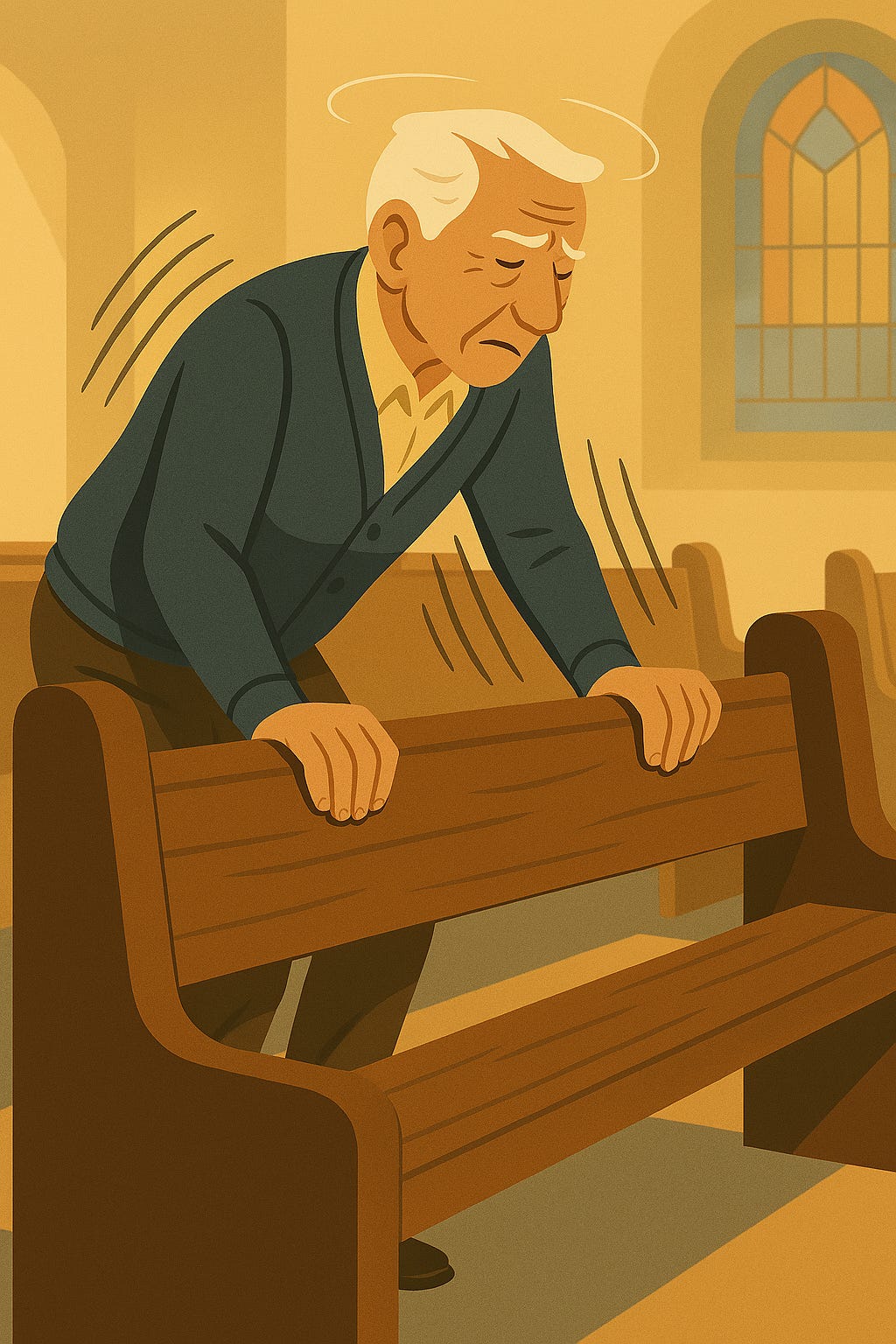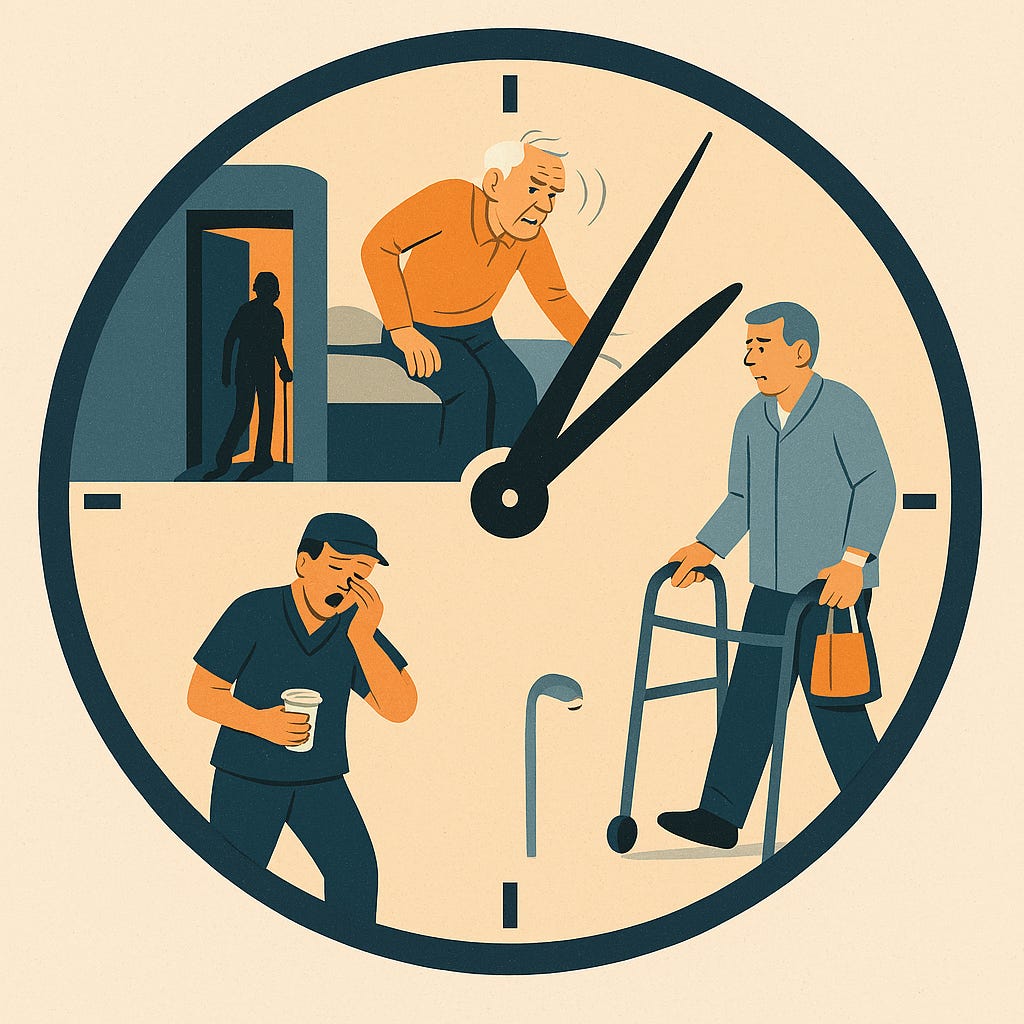Gravity Never Sleeps
The Hidden Hours of the Day When You’re Most Likely to Fall
The Call at 6:30 AM
It’s 6:30 in the morning, and the call comes in: a woman in her 70s collapsed in her kitchen. She’d just gotten out of bed, walked a few steps, and suddenly felt dizzy. By the time EMS arrived, she was on the floor with a nasty gash on her forehead.
Later that same week, EMS is called out just after midnight. Different patient, different neighborhood, same story: a man in his 50s, groggy from sleep and medication, tripped on his way to the bathroom.
And then there are the post-shift calls — firefighters, nurses, factory workers. People who’ve been awake for 20+ hours, running on fumes, and suddenly their body betrays them.
Different ages, different settings, but one thing in common: the timing wasn’t random.
The Science of “Danger Hours”
Falls don’t happen evenly across the day. They cluster at certain times, when the body is most vulnerable.
Morning: The Wake-Up Call
After hours of lying down, blood pressure is lower, joints are stiff, and balance reflexes are sluggish. Standing up too quickly can trigger dizziness or orthostatic hypotension. Research shows that older adults with frailty are especially prone to impaired blood pressure regulation when standing — a setup for falls (Romero-Ortuno et al., 2011).
I’ve seen this play out not just in kitchens and bedrooms, but in churches. More than once, I’ve responded to calls where an older adult, after sitting through a service, stood up for a hymn or to leave and suddenly blacked out. While there aren’t large studies that track falls specifically in worship settings, the physiology makes sense. Prolonged sitting followed by sudden standing is a classic trigger for orthostatic hypotension. Add in warm environments, medications, and the pressure to stand quickly, and it’s easy to see why worship services are a time to be extra vigilant.
Night: The Midnight Trap
Fatigue, sedatives, and bathroom trips combine to make the midnight hours especially dangerous (as we saw in the last article). Nocturia — the need to get up at night to urinate — is one of the strongest predictors of falls in older adults. A large community-based study confirmed that the more often people got up at night, the higher their fall risk (Nakagawa et al., 2010).
I’ve lost count of how many times I’ve responded to the same scene: a dimly lit bathroom, a hard tile floor, and someone who thought they were just making a quick trip in the night.
Post-Shift: Fatigue and Circadian Disruption
For shift workers, fatigue and disruption of the normal sleep cycle create a perfect storm. Reaction times slow, attention drifts, and the risk of tripping or stumbling rises. I’ve seen firefighters stumble after a 24-hour shift, nurses trip in hospital corridors, and factory workers misstep at the end of a long night.
The science backs this up: sleep deprivation impairs balance and coordination in ways similar to alcohol. In other words, being awake too long can make you just as unsteady as being drunk.
Post-Hospital Discharge: The Hidden Window
The first two weeks after leaving the hospital are another hidden danger window. New medications, deconditioning after an extended time in a bed, and disrupted routines make falls far more likely. One study found that people who needed help walking when they left the hospital had a higher risk of falling and were more likely to lose their independence. (Mahoney et al., 1999).
I’ve seen this in real life: patients who were steady before a hospital stay come home weaker, slower, and more vulnerable than they realized. It’s a time when families need to be especially vigilant.
Why Timing Matters
Understanding these “danger hours” changes the way we think about prevention. It’s not just about removing rugs or adding grab bars; it’s about knowing when you’re most vulnerable and adjusting your behavior.
If mornings are your weak spot, take your time getting up, hydrate before moving, and stretch stiff joints. If nights are risky, light your path and pause before standing. If you’re a shift worker, recognize that fatigue is as dangerous as alcohol when it comes to balance and coordination. And if you’ve just come home from the hospital, treat those first two weeks like a recovery zone: move slower, ask for help, and don’t push your limits.
The Takeaway
Falls aren’t random accidents. They’re predictable events that often strike at predictable times. By paying attention to your body’s rhythms and respecting the hours when you’re most vulnerable, you can stack the odds back in your favor.
Because gravity never sleeps. But you can outsmart it.
Looking Ahead to the Next Article
We’ve talked about when falls happen. But what about when prevention fails? What if, despite your best efforts, you still go down? In the next article, we’ll flip the script and talk about something almost no one teaches: how to fall better.
Closing Call-to-Action
Have you ever noticed certain times of day when you feel more unsteady — first thing in the morning, late at night, or after a long shift? Share your experience in the comments, or share this article with someone who might need the reminder. You might just help them avoid their own “danger hour.”




